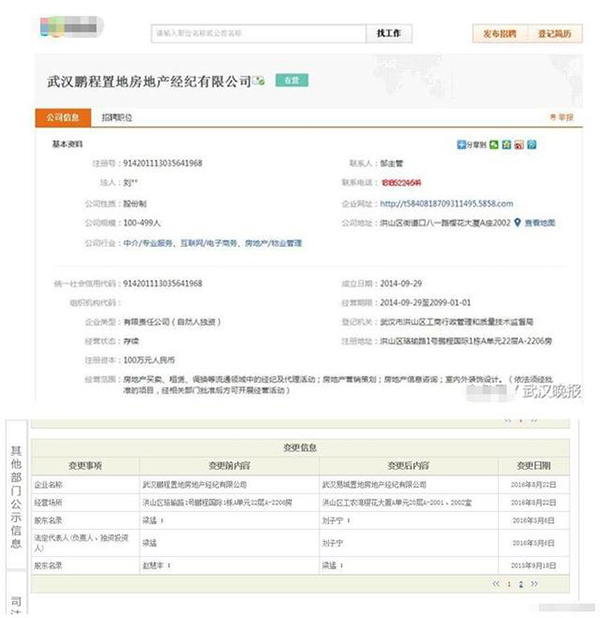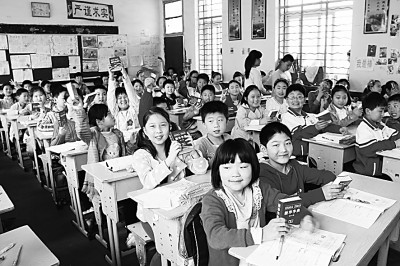"Everyone else is sunbathing and eating in the circle of friends. I am looking for a house throughout the holiday and I have to light candles when I go home at night." Recently, Huang Ting (pseudonym), who was full of grievances, said that he had never thought that he had just entered the society from the university and suffered such a blow.
In several rights groups, there are more than 200 people, like Huang Ting and Ms. Wang. Some are tenants and some are landlords. Because the intermediary company has been in arrears for several months, the landlord can’t collect the rent and has to drive away the tenants.
The reporter’s investigation found that there are tricks behind these intermediary companies, and the former employees of the company said that "there are all routines inside". One of the intermediary companies also threatened reporters that "you will lose your job if you report again".

I was evicted by the landlord just after two days.
In August this year, Huang Ting, who just graduated from university, finally found a good job in Wuhan. For the convenience of going to work, she rented a single room in Hankou and rented 800 yuan every month.
"A house was divided into four single rooms by the intermediary and lived in four tenants. The rent is paid for one and three, plus the property fee for a whole year, totaling 3,800 yuan. " Huang Ting said that several "neighbors" who live together are also office workers who have just graduated. In order to make the living environment better, everyone bought wallpaper and plastic flowers respectively and decorated the room.
Who knows, on the third day, Huang Ting and two other roommates were blocked in the house by the landlord. The landlord said that the house was entrusted to the housing agency "Anju Weiye", but the company has been in arrears for one quarter. "The landlord asked us to move out within three days, otherwise we would throw our things out." Huang Ting said that she immediately called the intermediary company, but the other party said, "You signed a contract with the company, and no one has the right to kick you out. If someone forces you to leave, you can call the police. "
"It’s not easy for the landlord to see us. Knowing that we are also victims, he said to give us a few days’ grace and wait until we find a new house before moving out." Huang Ting said that she had spent all her savings in renting this house, and it was difficult to take time off to look for a house after she had just worked. After several other roommates moved out one after another, she still "stayed" and dragged on for more than half a month.
"The landlord couldn’t stand it at last. He cut off the water and electricity directly, and he was rude to speak. Let me get out." Huang Ting said that she can understand the landlord’s feelings, but due to objective conditions, she can only "stay" until the National Day holiday before she can find a new house.
Yesterday, she borrowed 2000 yuan from her classmates and rented a smaller single room again, ready to move in that night. "I’ve been lighting candles for half a month. I can’t stand the lack of electricity and water." Huang Ting said that she had repeatedly asked Anju Weiye for the remaining rent, but the other party still told the same story: the landlord had no right to ask the tenant to move out, and if the landlord harassed the tenant, the tenant could call the police. If the tenant moved out on his own, it was a free act, and the intermediary company could not refund the remaining rent.
"I also reported to the police. After the police arrived at the scene, they said that this was a contract dispute and let me mediate with the intermediary and the landlord." Huang Ting said that she persisted for more than a month and reported to the industrial and commercial departments and the housing management departments successively, with no results. She decided to give up her rights protection and start a new life.
More than 200 people are caught in a "triangular debt"
Through Huang Ting, the reporter has met several other tenants and landlords, who belong to different real estate agencies and have encountered the same problem.
"I gave the house to the intermediary and signed a three-year contract, with a total rent of more than 70,000 yuan, which was paid quarterly. The intermediary company also asked for rent-free for the first two months, and I agreed. Now, they owe me a quarter’s rent, which has been delayed for more than half a month. " The landlord, Ms. Guo, said that she also visited the tenants and found that all the tenants were young, about the same age as her own children, and could not bear to evict them immediately, but the house could not always let these tenants live for free.
"I went to the intermediary, and the intermediary directly said that there was no money. Let me agree to postpone payment for three months, or let me call the police. This is completely rogue. I can’t ask the tenant for money again, and the intermediary has this attitude, so I have to drive the tenant out. " Ms. Guo said that she joined a rights protection WeChat group, which has more than 120 members, most of whom are tenants and a small number of landlords, all of whom are caught in a "triangular debt" because of "living in a good home".
In another rights group, there are 84 members, and their situation is more complicated than that of Huang Ting.
"We met three companies, Pengcheng Land, Yicheng Land and Jiangcheng Land. These three companies don’t know anything about each other and can’t explain clearly." Miss Chen, the tenant, said that she rented a single room at A2206 Pengcheng International Building at the street crossing in April through the intermediary company "Pengcheng Land". In August, she was approached by the landlord and asked to move out. Miss Chen went to Pengcheng International Building to negotiate and found that the building was empty.
"Call in the past, they said they moved to the cherry blossom building in Wuchang. However, when I went to the Sakura Building, I found that the sign of’ Yicheng Land’ was hung, and the other party said that it had nothing to do with them. " Miss Chen said that in the rights protection group, many people signed contracts with Pengcheng Land, and now they don’t know who to look for to protect their rights.
The landlord Cai Min (pseudonym) entrusted the house to the intermediary company "Jiangcheng Land" in Room A2506 of Pengcheng International at the beginning of this year. In September this year, she went to Room A2506 of Pengcheng International because the rent was in arrears, and found that the building was empty. As a last resort, she also issued a "eviction order" to tenants.
Frequently changing the "vest", there are tricks behind the three companies.
The reporter of Wuhan Evening News inquired through the national enterprise credit information publicity system and found that there was a certain relationship among Wuhan Pengcheng Real Estate Agency Co., Ltd., Wuhan Yicheng Real Estate Agency Co., Ltd. and Wuhan Jiangcheng Real Estate Agency Co., Ltd.
According to the system search, the relevant registration information of "Pengcheng Land" cannot be found. However, according to the information searched by Yicheng Land, the company was founded in 2009. On August 22nd this year, it was changed from Pengcheng Land to Yicheng Land, and its registered address was changed from Pengcheng International A2206 to Sakura Mansions A2001 and A2002. Moreover, in September last year, the company changed its legal person from Zhao Huifeng to Liang Meng, and in May this year, it was changed from Liang Meng to Liu Zining.
According to the search of "Jiangcheng Land", the company was established in April 2015, the date of license approval was June 6 this year, and the registered address was Pengcheng International A2506. In June this year, the legal person of the company was changed from Xu Jing to Liang Meng.
In 58 cities, you can also find the recruitment posted by Pengcheng Land in the last two days, which shows that its company address is "Sakura Building A2002".
The reporter went to "Yicheng Real Estate" for an interview. A man surnamed Liu said with a northeast accent: "Yicheng and Jiangcheng used to be Pengcheng Real Estate, but later they set up separate companies. In the past, when I was in Pengcheng, there were three partners, each with his own team, who jointly used the contract of "Pengcheng Land", but the list signed by each member was counted by each team. Now that the partners are dismissed, Pengcheng Land is gone. Some people come with the contract of Pengcheng Land, saying that what disputes occur depends on which team member signed the contract at the beginning. If it is signed by our people, I will recognize it. It may also be signed by other teams, so go to another company. "
The reporter showed him the information found on the industrial and commercial website, indicating that from industrial and commercial registration, "Yicheng Land" was changed from "Pengcheng Land", and the tenant and landlord took the contract of "Pengcheng Land" to find it. Should "Yicheng Land" be handled? The man surnamed Liu said, "What about the change? It has nothing to do with us. Why are you looking for us?".
The reporter of Wuhan Evening News contacted a salesman named Bao of "Jiangcheng Land" by telephone on the contract, asking about the company’s new office location and whether it was in arrears with the landlord’s rent. The other party said: "My phone is always open. If there is any problem, let them contact me directly. I have nothing to tell the media."
The reporter was threatened by the scene to "smash the rice bowl"
When the reporter interviewed "Anju Weiye", he met several tenants and the landlord who were negotiating on the spot. The landlord was asking for rent. The tenant was reporting that the house had been cut off and the landlord asked for the house. Due to the tenant’s alarm, two police officers came to the scene. The police checked the relevant information of both parties and asked the tenant to negotiate with the intermediary and then left.
A burly man, also with a northeast accent, loudly reprimanded the tenant: "You are quite capable, aren’t you calling the police?" If the landlord catches you in the future, don’t look for me, and then call the police! "
When the reporter expressed his wish for an interview, the man replied loudly: "What’s so exciting? It was reported by you last year, and now the company has no money and can’t collect the rent because it was reported. If you report again, we’ll come to you. Wait, I’ll smash your job. Do you believe it? !”
When the reporter saw that the interview could not be carried out, he turned and went downstairs, and found that there were seven or eight people downstairs who rushed to the tenants and landlords and were preparing to organize a delegation to negotiate.
"We went to the Housing Authority and said that it was under the control of the industry and commerce. The industry and commerce said that we should call the police. When the police came, they said that we should coordinate or prosecute ourselves. After dragging on for more than half a month, these people now know the attitude of the relevant departments, and they become very evil, and they are always threatening us. We are too few to go up. " The landlord, Ms. Liu, said that people who have been dragged into disputes are all over Wuhan, and everyone has been dragged out.
Former employees said that "it is full of routines."
Last summer, and at the beginning of this year, many local media in Wuhan reported one after another that the tenants were driven away by the landlord because the real estate agents did not pay the rent after collecting it. The Wuhan Housing Authority also publicized 16 real estate agencies in the Wuhan Evening News to remind the public of the transaction risks.
Through these reported company names, the Wuhan Evening News reporter found six or seven former employees who had worked in different companies such as Pengcheng Land and Jiangcheng Land, and learned some inside information from them.
Yan Yan (pseudonym) only left Pengcheng Land in early September this year because "I feel that some practices are unacceptable to me". Listening to the reporter talking about the recent dispute, she bluntly said that "there are routines here."
Yan Yan introduced that when the company rents a house, it will be rented into small single rooms. After signing a contract with the landlord, things will not be controlled by the landlord. "The intermediary will ask the landlord to waive the rent for one month or two months on the grounds of time buffer. On the other hand, the intermediary will collect rent from tenants on a quarterly or even annual basis, and then repeatedly collect property fees, health fees, elevator fees and so on. When the money is received, the intermediary has the final say. They use the time difference to take it out for investment or take it elsewhere for turnover, and sometimes there will be arrears. " Yan Yan said that once the landlord and tenant come to the door, the intermediary will first patiently find reasons to delay, and finally will even be scared and even rogue. If there is a tenant or landlord with excessive behavior, the intermediary will call the police.
"For tenants, things have gone wrong, and the most important issue is to find a foothold again; For the landlord, the house is in the hands of the intermediary, and the most important issue is to generate value as soon as possible. After complaints from various departments, they found that they could only sue, but the prosecution took a long time and could not solve the immediate problems. " Yan Yan said that she worked in Pengcheng International Building’s "Pengcheng Land" for half a year, and later moved to Sakura Building, and found that they were all the same routines, and she resigned decisively after "feeling uneasy inside".
(The original title is "More than 200 people are trapped in the intermediary routine! College graduates were driven away as soon as they checked in.)


 "la vie en rose" stills
"la vie en rose" stills
 Stills of spy league
Stills of spy league
























